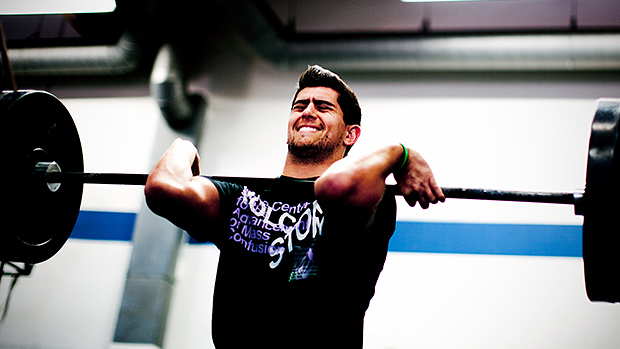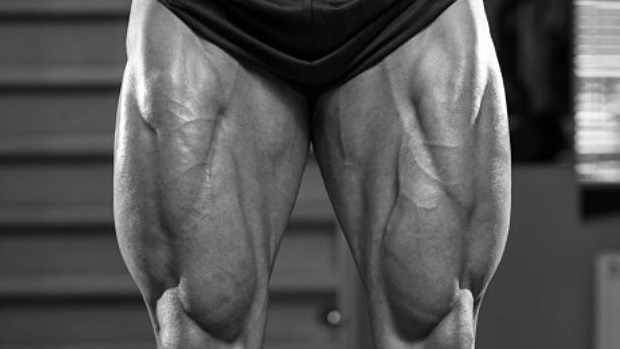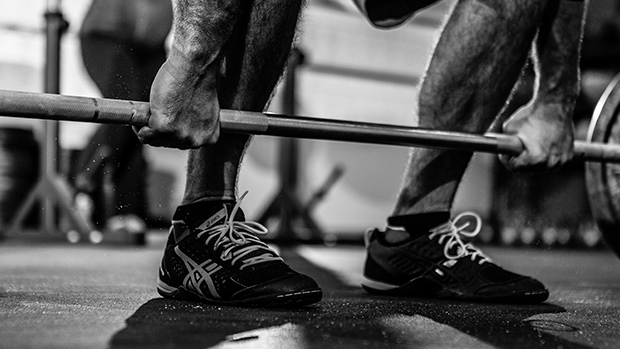Change, Dumb Comments, and Macho Crap
Insanity is often defined as doing the same thing over and over again and expecting different results. In the field of strength development, this concept applies directly to exercise selection. In order to prevent injuries we need to be able to change.
We may only need to change grips or bar positions, but the important thing is that we do need to change. The mark of a great coach in any sport is one who's willing to adapt to changes. We need to be able to avoid the insanity. We need to stop doing the same things over and over while expecting different results.
Eric Cressey's recent interview with me, The Misunderstood Strength Coach, produced some great posts that really made me think. The most interesting posts were in regard to injuries. One writer stated:
"Looks a bit paranoid about injuries. If you're training to get good, you have to lay it on the line. People get hurt in practice and you know, once in a while, they get hurt in the weightroom."
Another post said:
"Injury prevention should never be the number one goal. You know the easiest way to prevent injury? Don't train or do any sport at all. Most strong guys have had some sort of injury in their lifetime."
Saying these comments were dumb might be a compliment. Let's look at this on a few levels.
Guess what? I am paranoid about injuries. Every good strength and conditioning coach should be. I guess I shouldn't even take offense. My response should've been, "Damn right I'm paranoid!" This article will hopefully explain how I deal with my paranoia and how my paranoia might help you.
As for "laying it on the line," I'm sure this is a reference to training hard. I don't think I've ever advocated not training hard, only choosing effective exercises that might minimize risk exposure.
Charles Poliquin uses a term I like called "technical failure." What it basically means is that the set ends when you can no longer do another correct rep. I'm a big believer in the technical failure concept. The set ends at technical failure, not when you can't cheat through another rep. I'd always rather undertrain than overtrain. Tomorrow is another day. The tortoise beat the hare. The healthy trainee lives to train another day while the hurt guy goes to PT.
I'll tell you when I want my guys to "lay it on the line." I want them to lay it on the line every set with perfect technique and stop when their technique fails. I also want them to go all out during our conditioning sessions. Lots of guys like the weightroom but are remarkably unfit. I'm a strength and conditioning coach and I put a premium on conditioning as well as strength.
Injuries in the weightroom? The reality is that athletes will get hurt in the weightroom from time to time. I'd agree with that premise. Again the key is to minimize exposure to potentially injurious situations and exercises. People also get hurt in games, but I believe most would rather not. There's nothing wrong with trying to run a safe program.
Strength is one of the best injury prevention tools in sport, but getting injured while training not to get injured is as stupid as it sounds. What trainee wants to be injured? Any takers? I gave up the macho crap years ago. I just want results.
Chainsaws and the Injury Prevention Model
An undisputed reality is that professional sport uses the avoidance of injury as the measuring stick of success in strength and conditioning. Shouldn't that tell you something?
Pro teams don't test squats or deadlifts. I don't know one professional sports team that does 1RM strength testing. That should also tell you something. Personally, I like 1RM tests, but probably not in pro sports.
One of my early influences was current San Francisco 49ers strength and conditioning coach Johnny Parker. I can remember Johnny saying, "Who needs testing? We have 16 tests a year!" The NFL uses a statistic called "Starter's Games Missed." The NHL uses a similar stat called "Man Games Lost to Injury." Same concept. Success as a strength and conditioning coach at the professional level is measured by keeping the best players playing.
What people don't understand is that all training is about assumption of risk. How much risk should I assume with this particular athlete or client? The way I train my college team is slightly different than the way I train my younger NHL guys, and it varies significantly from how I train my veterans. Many of my older (30-plus) clients no longer do conventional squats or Olympic lifts. Their bodies no longer tolerate it. We do jump squats, kettlebell swings, and lots of single leg stuff with these guys because the objective is to keep them playing.
My college guys do hang cleans, hang snatches, front squats, and bench presses: a much more conventional approach. The key is finding the right tool for the job. I have a saying I use in my seminars: "Chainsaws are bad for molding." Some guys just love the chainsaw, but it's really only a good tool for cutting up trees. Use the right tool for the job.
Mutual Exclusivity?
The real key is that strong and healthy aren't necessarily mutually exclusive. I'm not a HIT fan, but HIT has lived off the idea that exercises like Olympic lifts and plyometrics are unsafe. I'm not from that school. I'm simply saying that we should make training as safe as possible through good exercise selections and sound progressions.
One thing I have is life experience. Many think I'm a skinny geek who never lifted. Looking at me, I might form the same impression. In truth, I'm a skinny geek who lifted twenty years ago.
I'm also fond of saying at seminars, "No one at Gold's ever asks me for advice. I wonder why?" It might be because I have rotator cuff problems in both shoulders (one surgery), have had twenty-five years of back pain, and a few knee surgeries to boot. That's why I love to laugh at the "lay it on the line" guys. Talk to me when you're 46!
Every day I have to make decisions that affect both the short term and long term health of my athletes and clients. I take that job seriously, and I read and study extensively. Ask yourself why Eric Cressey and Mike Robertson have become so popular on this site. I can tell you: they tell people how to hurt less.
That means there are a lot of hurt people reading T-Nation. They got that way the same way I did: by laying it on the line. There was a time I believed that everyone should have a sore back for a week after a deadlift workout and that everyone iced their shoulders and took Advil after every pressing workout. I now know that wasn't true. I want my athletes to have all the benefit that science and experience can provide.
There are two categories of injuries. Lower body training tends to cause back trauma. Most back injuries tend to be acute and a result of a technical failure. Upper body injuries tend to be overuse in nature and related more to what the trainee may not be doing. So, here are my recommendations to make training both safe and effective.
8 Ways to Train Safely and Effectively
1 – Switch to Front Squats

Back pain has three root causes as it relates to lifting. Torque (forward lean), compression (high spinal loads), and flexion are what cause back injuries. Front squats lessen torque, compression, and flexion, and are therefore inherently safer.
I've written before that you can't front squat badly. The truth is you probably can front squat badly, but it's a lot easier to back squat badly. In general, if you front squat poorly, you'll dump the bar.
However, there are three major reasons people still do back squats versus front squats:
- They always have. (A bad reason, but people really hate change.)
- They can lift more weight. (Ego is always a big problem).
- They perceive front squats as difficult due to poor wrist flexibility.
Number three is easily solved with an old Charles Poliquin trick. Just add straps to the bar.

The truth is that front squats decrease spinal load and improve back position – two positives in my book. My athletes and clients haven't done a back squat in about seven years. We have very little back pain. We still front squat relatively heavy. My college players front squat between 300 and 350 pounds to powerlifting depth at bodyweights of 180-200 with no wraps and usually a Velcro belt.
2 – Forget the Leg Press
If you can't squat, please don't leg press. I'd like all of my athletes and clients to front squat, but once an athlete has a history of back pain we will use alternatives. One that we don't use is the leg press.
We never leg press. I haven't had a leg press in one of my facilities for over ten years! The leg press is good for only one thing: inflating the ego. There are far better ways to work the lower body if you're unable to squat. They just don't allow you to use huge weights. The only thing worse than a man leg-pressing is a man leg-pressing with knee wraps.
3 – Avoid Knee Wraps
Knee wraps are not an injury prevention tool. They're an elastic launching pad to allow you to lift more weight. Knee wraps don't protect the knee.
If you have knee issues and like the feel of something on your knee, use Neoprene sleeves. I'm a raw guy all the way. No belt or a cheap Velcro belt, no wraps.
If you compete in powerlifting, this is a different story. Throw on your gear in the last few weeks to get ready, but don't train with it.
4 – Try Belt Squats

This is an old Westside favorite and is a great way to work the lower body when injured. I generally prefer to work the lower body with single-leg exercises if an athlete or client can't squat, but we've had athletes in the past do nothing but belt squats for an entire season to rest a sore back and then have had the same athlete squat a PR.
Belt squats are particularly good if you're a low bar, forward-lean squatter.
5 – Try One-Leg Squats
There are lots of variations of the one-leg squat. I think the video below demonstrates what I consider to be true strength.
Most lifters don't like one-leg squats. You know why? Because they're hard and they take some coordination. However, if you want to minimize back stress and maximize leg work, give them a try.
You don't need a lot of weight to get a great leg workout as your bodyweight immediately becomes a part of the load. Our athletes one-leg squat to a soft touch on a 14" box and have used 100 pounds of external load (25 pound dumbbells in each hand and a 50 pound weight vest).
The additional benefit of the one-leg squat is great stabilizer loads on the abs and adductors.
6 – Dump Conventional Deadlifts
I know this will piss off the powerlifters, but I don't like deadlifts. I'm a former powerlifter and I've written this numerous times.
Go to a powerlifting meet and watch the entire meet. You'll see lots of great squat technique, but you won't see lots of flat back deadlifts. Nothing is worse for a back than flexion. Flexion, torque, and compression, as mentioned above, are big back offenders. It isn't easy to deadlift well. It's much easier to deadlift heavy than to deadlift well. I know that every morning when I get up.
I do, however, love single-leg versions of the modified straight leg deadlift. (I hate the term Romanian Deadlift. A great strength coach once said, "I was doing those before I knew where Romania was.") With single-leg deadlifts, the hamstring gets all the load while the back gets half.
7 – Clean from the Hang
Now I'm trying to piss off the Olympic lifters (if I didn't already with my RDL comment). I'm not trying to be popular; I'm trying to make people think. I like to describe it as a good swift kick in the comfort zone.
Bottom line: hang cleans are safer than cleans from the floor. Cleans from the floor are easier for short people. The diameter of a 20K plate is a constant. What makes someone a good athlete often makes him a bad Olympic lifter. Hang cleans are the great equalizer.
Everyone starts from the same position. It's often difficult for taller athletes to get into a proper start position for a clean from the floor. This again puts the low back at risk as athletes attempt to position themselves for the clean.
8 – Try Dumbbell Snatches and Close Grip Snatches
I believe that the snatch is actually a better and safer lift than the clean. The reason most coaches don't like the snatch is that they've never tried it.
Cleans can be very limited by flexibility. Snatches are easier to learn as almost everyone can get the bar overhead. The catch position of the clean can be difficult to master. The best way to learn to snatch is to dumbbell snatch first.
The dumbbell snatch is the first explosive lift we teach and, if allowed to do only one Olympic-type lift, I'd choose the dumbbell snatch. Dumbbell snatches work on core strength and unilateral shoulder strength as well as hip and leg power.
Upper Body Injuries
I think upper body injuries relate more to the exercises you're not doing than to the ones you are. What does this mean? It means that a lack of pulling strength is probably the reason so many lifters have rotator cuff problems.
I think it boils down to two things. Not enough rowing (horizontal pulling) and not enough vertical pulling (chins, etc). My athletes have zero incidence of rotator cuff tendonitis. My average athlete can also do a 1 RM chin-up with more than he can bench press.
We actually tested this. One-rep max was calculated by adding the amount of weight the athlete can use for one rep to the athlete's bodyweight. I strongly believe that the pull/push ratio here should be a minimum of 1:1. In other words, a 180 pound athlete who can bench 280 should be able to perform a one chin-up (supinated grip) with 100 pounds.
Treat your vertical pulls just like the bench. Cycle them. Do heavy triples. Whatever you do for horizontal presses, do the same for vertical pulls. Your shoulders will love you for it.
I haven't been able to calculate a proper ratio for rows, but again, I think an athlete with proper pulling strength should be able to dumbbell row about 80% of what he can dumbbell bench. In other words, an athlete performing dumbbell bench presses with 100 pound dumbbells for five reps should be able to dumbbell row with 80 pound dumbbells for five reps.
In addition, all athletes should eventually be able to perform 10-15 inverted rows with the bar at bench press height and the feet elevated 18". In the inverted row, the athlete should be able to touch his chest to the bar without cheating. Many strong bench pressers will not be able to do one initially and will immediately move to the copout stuff like "I'm not flexible enough to do that."
You need to remind them if they can lower a bar to the chest, they should be able to pull the chest to the bar. What they lack is true scapula retraction strength. I've seen many 400 bench pressers who couldn't do five good reps.
One interesting point: I've never seen an NFL lineman who couldn't do one chin-up, but have seen many who couldn't do one good quality inverted row.
The Bottom Line
Change is good. Don't throw out the basics, but don't be so stuck in the imitation mode. If you're not a competitive powerlifter, you don't need to train like one. If you're not a competitive Olympic lifter, you don't need to train like one.
The key is to take the best of each system on a piece-by-piece basis to get a result. I use Yoga stretches, core exercises taken from Pilates, and strength cycles from the best in Olympic and powerlifting. What I don't do is use a chainsaw for molding.





